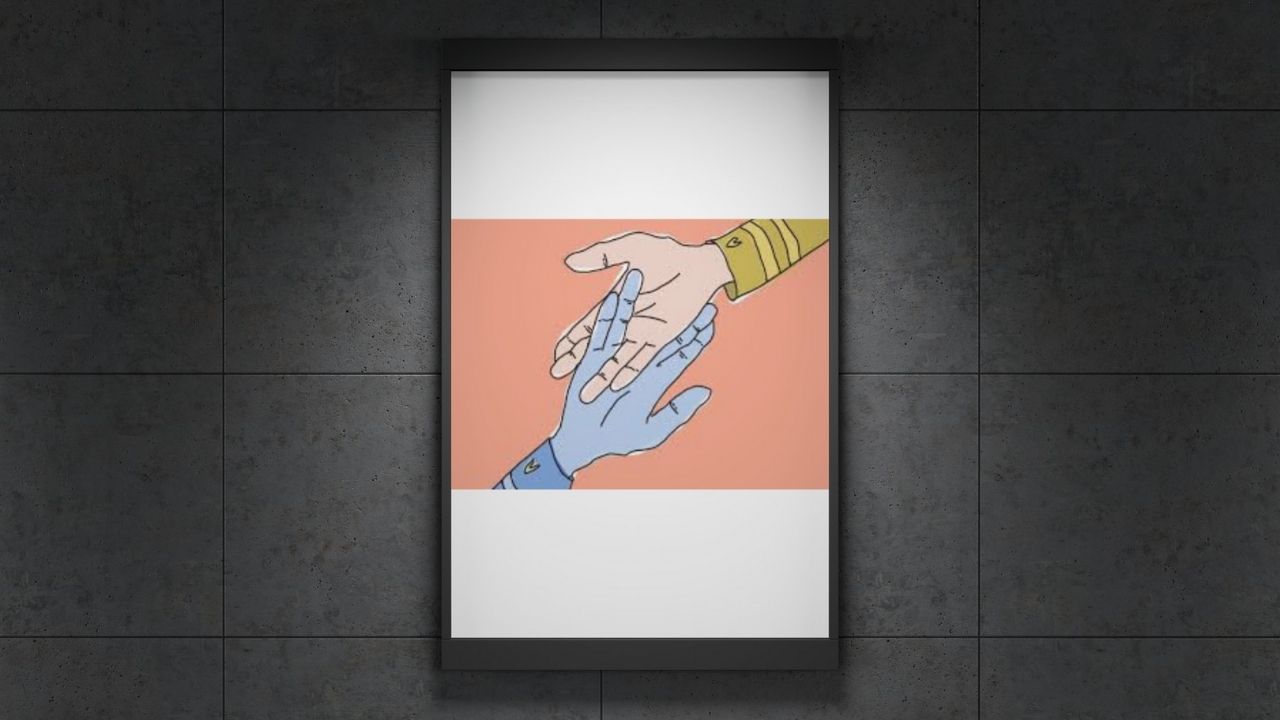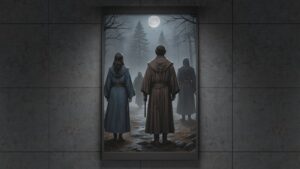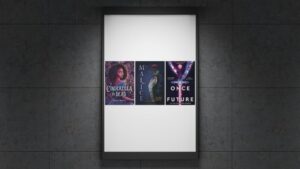Villains have always captivated our imagination, often stealing the spotlight with their charisma, complexity, and the sheer audacity of their plans. In fantasy narratives, they serve as the perfect foil to heroes, embodying the challenges, fears, and moral dilemmas that drive the story forward. Whether we love to hate them or find ourselves reluctantly rooting for their cause, villains play an indispensable role in shaping the worlds we lose ourselves in.
In recent years, fantasy storytelling has evolved to embrace greater diversity, both in the worlds created and the characters that populate them. This shift has brought with it more nuanced portrayals of LGBTQIA+ individuals, including villains who defy traditional stereotypes. These characters are no longer confined to being coded as “other” for shock value or as a subversive trope but are instead given rich backstories, authentic motivations, and a sense of agency that makes them as compelling as the heroes they oppose.
This article explores how LGBTQIA+ villains contribute to the depth and complexity of modern fantasy narratives. By challenging tropes, enriching storylines, and fostering meaningful representation, these characters offer audiences new ways to engage with the genre while reflecting broader societal changes.
The Evolving Role of Villains in Fantasy
For much of literary history, villains in fantasy were often painted in broad strokes. They were the embodiment of evil, the faceless antagonists whose primary function was to oppose the hero and drive the plot. Their motivations were simple—greed, revenge, or a lust for power—and their actions were often predictably malevolent. While these one-dimensional portrayals provided a clear moral framework for stories, they left little room for complexity or nuance, making these villains more plot devices than fully realized characters.
Modern fantasy, however, has ushered in a new era of storytelling where villains are no longer confined to such simplicity. Today’s antagonists are frequently portrayed as morally complex individuals whose choices, though misguided or harmful, stem from relatable emotions or lived experiences. These characters challenge traditional notions of good versus evil by inhabiting the gray areas of morality, inviting audiences to question their own assumptions and biases.
This evolution is particularly significant in the context of representation. For decades, marginalized identities—including LGBTQIA+ individuals—were either erased from fantasy narratives or portrayed through harmful stereotypes. Queer-coded villains, for example, often reinforced negative associations between queerness and deviance, framing LGBTQIA+ traits as “other” or threatening.
The shift towards multidimensional villains has opened the door to richer, more meaningful representation. Writers now have the opportunity to create characters who reflect the diversity of human experience without reducing them to caricatures. By moving away from stereotypes and tokenism, modern fantasy acknowledges the complexity of identity, crafting villains who are not defined solely by their LGBTQIA+ status but are instead multifaceted individuals whose queerness is one aspect of their larger narrative.
This progress is not just about better storytelling—it’s about challenging societal norms and offering representation that resonates with audiences. A morally complex villain with an LGBTQIA+ identity can spark conversations about power, prejudice, and resilience, providing a lens through which readers and viewers can explore both the fantastical and the deeply personal.
LGBTQIA+ Representation in Villainy
The portrayal of LGBTQIA+ characters as villains has a complicated history. From problematic origins rooted in stereotypes to the nuanced and empowering reimaginings seen today, the evolution of queer representation in villainy highlights both the challenges and opportunities in modern storytelling.
Historical Context: The Problematic Trope of Queer-Coded Villains Historically, many villains in literature, film, and fantasy were coded as queer without explicitly identifying as such. This coding often manifested through exaggerated flamboyance, effeminate mannerisms in male villains, or the subversion of traditional gender norms. These traits were used as shorthand to signal “otherness,” associating queerness with deviance, danger, or moral corruption.
Examples include classic Disney villains like Scar (The Lion King) and Ursula (The Little Mermaid), both of whom exhibit characteristics often associated with queer stereotypes. Ursula’s design, for instance, was famously inspired by the drag queen Divine, while Scar’s smooth, theatrical demeanor sets him apart from the more conventionally masculine heroes. While iconic, these portrayals reinforced negative perceptions by equating queerness with villainy and alienation.
The prevalence of these tropes reflected societal prejudices of the time, using queerness as a marker of something “unnatural” or threatening. This approach not only stigmatized LGBTQIA+ identities but also reduced queer-coded characters to caricatures, denying them depth or humanity.
Modern Reimaginings: Writing LGBTQIA+ Villains with Nuance and Depth In recent years, creators have sought to reclaim and reimagine LGBTQIA+ villains, giving them the complexity, agency, and depth that earlier portrayals lacked. Rather than relying on stereotypes, modern narratives explore the motivations, struggles, and identities of queer antagonists in ways that feel authentic and multifaceted.
These characters are no longer defined solely by their queerness or framed as villains because of it. Instead, their LGBTQIA+ identity becomes one facet of a larger, more intricate personality. They are written as fully realized individuals with compelling backstories, motivations, and arcs that resonate with audiences.
This shift not only enriches the narrative but also challenges traditional power dynamics. LGBTQIA+ villains are often positioned as agents of change, disrupting societal norms and forcing both characters and viewers to confront uncomfortable truths about power, identity, and acceptance.
Examples: Popular LGBTQIA+ Villains in Contemporary Fantasy Media
- Azula (Avatar: The Last Airbender) Azula’s character is often read through a queer lens due to her subversion of traditional gender roles and her relationships with other female characters. While her sexuality is not explicitly defined, her complex psychology and descent into madness reflect the pressures of societal expectations and family dynamics. Azula’s arc offers a tragic yet layered exploration of power, control, and vulnerability.
- Hannibal Lecter (Hannibal) In the television adaptation, Hannibal Lecter’s relationship with Will Graham has strong homoerotic undertones, adding depth to his character. Hannibal’s queerness is not portrayed as the root of his villainy but as a natural aspect of his identity, making him a nuanced and morally ambiguous figure.
- The Darkling (Shadow and Bone) Though not explicitly queer, the Darkling’s androgynous charm and emotional depth resonate with queer-coded narratives. His manipulation of Alina Starkov and desire for acceptance mirror struggles faced by those who feel alienated or misunderstood. His character challenges traditional notions of masculinity, presenting power as something rooted in vulnerability and ambition.
- Alecto (Priory of the Orange Tree by Samantha Shannon) Alecto’s role as a queer-coded antagonist in Shannon’s epic fantasy is notable for its depth and intricacy. Her relationships, ambitions, and worldview reflect both her queerness and her humanity, offering a refreshing take on LGBTQIA+ villainy that avoids the pitfalls of tokenism.
A Complex Legacy
The portrayal of LGBTQIA+ villains has come a long way from its problematic origins. Modern reimaginings offer richer, more nuanced characters that reflect the diversity and complexity of queer experiences. By reclaiming these roles and writing them with depth and agency, creators are turning a once-problematic trope into an opportunity for meaningful representation, transforming the fantasy genre in the process.
Why LGBTQIA+ Villains Resonate
In modern fantasy, LGBTQIA+ villains hold a unique and compelling place in storytelling. These characters do more than serve as antagonists—they challenge conventional hero-villain dynamics, bring fresh perspectives to well-worn tropes, and offer audiences an opportunity to engage with narratives that feel both personal and universal.
Subverting Expectations Traditional fantasy narratives often rely on clear moral dichotomies, where the hero is inherently good, and the villain is irredeemably evil. LGBTQIA+ villains, however, often upend these conventions by embracing complexity and defying predictable roles. Their motivations, struggles, and desires frequently blur the lines between right and wrong, forcing audiences to question their assumptions about morality, justice, and even the nature of heroism itself.
For example, a queer villain may fight for a cause rooted in legitimate grievances, such as seeking justice for societal rejection or oppression. While their methods might be extreme, their motivations are understandable, if not relatable. This layered approach to character-building allows these villains to transcend the simplistic “evil for evil’s sake” archetype and instead become catalysts for deeper, more meaningful storytelling.
Themes of Identity, Rejection, and Empowerment LGBTQIA+ villains often embody themes of identity and rejection, reflecting the real-world struggles many queer individuals face. Their stories may include experiences of being cast out, misunderstood, or forced to live in the shadows—a common thread for those who exist on the margins of society. By embracing their identity and leveraging it as a source of power, these characters can also represent empowerment, turning adversity into strength.
For example, a queer villain might use their experiences of rejection to fuel their ambition or create a world where they no longer have to conform to societal norms. This narrative arc resonates with audiences who have faced their own challenges related to identity and acceptance, offering a sense of validation and catharsis through the character’s journey.
Relatability and Resilience What makes LGBTQIA+ villains particularly resonant is their relatability. Despite their status as antagonists, these characters often reflect the resilience and resourcefulness of individuals who have had to navigate a world that doesn’t always accept them. Their struggles, whether with societal prejudice or internal conflict, mirror the real-life experiences of LGBTQIA+ people, making their stories profoundly impactful.
Moreover, these villains challenge the idea that queer characters must always be virtuous or morally upright to be worthy of representation. By portraying LGBTQIA+ individuals as complex, flawed, and fully human—even when they inhabit the role of the villain—modern fantasy celebrates the diversity of queer identities and experiences.
In essence, LGBTQIA+ villains resonate because they reflect both the pain and power of existing outside societal norms. Their narratives subvert expectations, explore themes of identity and empowerment, and invite audiences to connect with their struggles and triumphs on a deeply personal level. As a result, they enrich the fantasy genre with stories that are as thought-provoking as they are entertaining.
Potential Pitfalls in Representation
As much as LGBTQIA+ villains can add depth and complexity to modern fantasy narratives, their portrayal comes with significant responsibilities. Writers and creators must navigate potential pitfalls to ensure these characters contribute meaningfully to representation rather than perpetuating harmful tropes.
Avoiding Harmful Stereotypes Historically, queer-coded villains have often been framed as inherently deviant or evil, with their queerness used to signal moral corruption or otherness. This practice dates back to times when queerness was taboo, allowing creators to imply LGBTQIA+ identities without overtly stating them. Such portrayals reinforced negative stereotypes, linking traits like flamboyance or gender nonconformity to villainy.
While modern narratives have moved toward more nuanced portrayals, the danger of slipping into old patterns remains. Writers must be cautious not to rely on surface-level traits to signify queerness or to conflate an LGBTQIA+ identity with moral depravity. Instead, a character’s actions, motivations, and depth should define their role as a villain, independent of their sexuality or gender identity.
Balancing Representation Another key challenge is ensuring LGBTQIA+ characters are not disproportionately represented as villains. While well-crafted LGBTQIA+ antagonists can be compelling, an overrepresentation of queer villains risks reinforcing the outdated notion that queerness is inherently “other” or “wrong.”
Representation should reflect the diversity of the LGBTQIA+ community, including heroes, side characters, and morally ambiguous figures. This balance not only normalizes queer identities within storytelling but also ensures that audiences see a full spectrum of experiences and personalities. Writers should aim to include LGBTQIA+ characters across a range of roles to avoid the perception that queer individuals are predominantly associated with villainy.
The Importance of Diverse Roles Diverse representation goes beyond avoiding stereotypes and balancing character roles. It’s about creating LGBTQIA+ characters who are fully realized, complex, and integral to the narrative. Queer villains, like all characters, should have rich backstories, authentic motivations, and multi-dimensional personalities that resonate with audiences.
Equally important is the inclusion of LGBTQIA+ heroes, mentors, and other positive archetypes. These roles counterbalance the presence of queer villains, demonstrating that LGBTQIA+ characters are not defined by their position on the moral spectrum but by the breadth of their humanity. By presenting queer individuals in diverse roles, fantasy narratives can foster representation that feels authentic, inclusive, and empowering.
In summary, while LGBTQIA+ villains can enrich storytelling, they must be handled with care. Avoiding harmful stereotypes, ensuring balanced representation, and creating diverse roles across the narrative spectrum are essential steps in crafting meaningful and responsible portrayals. By doing so, creators can celebrate the complexity of LGBTQIA+ identities while contributing to a more inclusive and equitable fantasy genre.
How LGBTQIA+ Villains Enrich Fantasy Narratives
LGBTQIA+ villains are reshaping the way modern fantasy approaches storytelling, offering layers of complexity and serving as powerful lenses through which deeper cultural and social themes can be explored. Far from being mere antagonists, these characters enhance narratives by challenging moral conventions, reflecting societal struggles, and sparking meaningful discussions about identity and representation.
Adding Complexity: Deepening Moral Ambiguity One of the most significant contributions LGBTQIA+ villains bring to fantasy narratives is their ability to add complexity and moral ambiguity. These characters often operate in the gray areas between good and evil, motivated by reasons that, while flawed, are deeply human and relatable. Their presence pushes audiences to think critically about the nature of morality, justice, and heroism.
For example, an LGBTQIA+ villain may have goals that, in another context, could be considered noble—such as fighting systemic oppression or seeking revenge for personal injustices. However, their methods may conflict with the values of the hero, creating tension and forcing both the characters and the audience to grapple with difficult ethical questions. This moral complexity elevates the narrative, making it more engaging and thought-provoking.
Exploring Rich Backstories: Reflections of Societal Prejudice and Personal Trauma LGBTQIA+ villains often carry rich backstories that delve into themes of societal rejection, marginalization, and resilience. These narratives can highlight how systemic prejudice, personal trauma, or a life of exclusion shaped their worldview and led them down a darker path.
Such stories resonate with audiences because they feel authentic and rooted in real-world experiences. For instance, a villain who was ostracized for their identity may reflect the struggles of many LGBTQIA+ individuals who face discrimination or are forced to suppress their true selves. These characters embody a sense of rebellion against a society that failed to accept them, making their motivations and actions more understandable—even if not condonable.
By presenting these layered backstories, fantasy narratives offer opportunities for empathy, encouraging audiences to see beyond the surface of a character’s villainy and understand the systemic forces that contributed to their descent.
Catalysts for Broader Discussions: Representation in Fantasy as a Mirror for Cultural Change Fantasy has always served as a reflection of the societies that create it, using otherworldly settings and characters to explore cultural and social issues. LGBTQIA+ villains act as catalysts for broader discussions about representation, identity, and power dynamics in both the fantasy world and the real one.
Through these characters, creators can challenge stereotypes, critique societal norms, and foster conversations about inclusion and equality. For example, a fantasy villain who fights for the freedom to live authentically, albeit through extreme means, mirrors real-world struggles for LGBTQIA+ rights and recognition. These parallels allow audiences to engage with contemporary issues in a context that feels both removed and deeply relevant.
Furthermore, the presence of LGBTQIA+ villains enriches the genre by demonstrating that representation doesn’t have to follow rigid guidelines. Queer characters can occupy any role—hero, villain, or somewhere in between—while still contributing meaningfully to the story. This diversity of representation reflects the complexity of human experience, offering a more inclusive and honest portrayal of the world we live in.
In conclusion, LGBTQIA+ villains enrich fantasy narratives by deepening moral ambiguity, providing rich and relatable backstories, and acting as mirrors for cultural change. They challenge audiences to think critically, empathize deeply, and engage with stories on multiple levels, ultimately elevating the fantasy genre and broadening its horizons.
Case Studies and Examples
LGBTQIA+ villains have gained prominence in modern fantasy, with creators crafting compelling, multi-faceted antagonists who challenge traditional storytelling norms. Let’s explore a few notable examples, analyzing their character arcs, motivations, and the ways their portrayal redefines conventional fantasy tropes.
1. Loki (Marvel Cinematic Universe and Norse Myth-Inspired Fantasy) Loki, a fan-favorite character across Marvel media and Norse mythology adaptations, embodies fluidity in both identity and morality. Confirmed as genderfluid and bisexual in Marvel’s Loki series, the character challenges traditional notions of villainy and representation.
- Character Arc and Motivations: Loki is driven by a mix of resentment, ambition, and a desire for recognition. Often cast as the “god of mischief,” his actions stem from feelings of being overlooked or undervalued, particularly in comparison to his brother, Thor.
- Narrative Impact: Loki’s charm, wit, and vulnerability make him more than a straightforward antagonist. His complex relationship with Thor and the people of Asgard highlights themes of family, identity, and redemption.
- Challenge to Tropes: Loki’s genderfluidity and bisexuality are not presented as causes of his villainy but as integral aspects of his identity. By normalizing these traits, Loki’s character offers an inclusive perspective while remaining a morally ambiguous figure.
2. The Darkling (Leigh Bardugo’s Grishaverse, including Shadow and Bone) The Darkling, a central antagonist in Leigh Bardugo’s Shadow and Bone series, is a character whose queerness is subtly implied through his connection with themes of power, isolation, and intimacy.
- Character Arc and Motivations: As a centuries-old Grisha, the Darkling’s primary goal is to protect his kind from persecution. However, his methods—manipulation, violence, and a thirst for control—place him at odds with the protagonist, Alina Starkov.
- Narrative Impact: The Darkling’s complexity lies in his mix of vulnerability and ruthlessness. He elicits both sympathy and fear, embodying the consequences of unchecked power and loneliness.
- Challenge to Tropes: While the Darkling’s queerness is not overtly stated, his character represents a break from traditional “macho” villain archetypes. His elegance, emotional depth, and intricate relationships with both male and female characters subvert rigid gender norms and expectations.
3. Cersei Lannister (HBO’s Game of Thrones and George R.R. Martin’s A Song of Ice and Fire) While not explicitly queer, Cersei Lannister has often been interpreted as a symbol of subversive femininity, with her complex relationships and nonconformity to traditional roles resonating with queer-coded narratives.
- Character Arc and Motivations: Cersei’s ruthless pursuit of power stems from a lifetime of being undervalued and dismissed because of her gender. Her motivations revolve around protecting her family and securing her position in a patriarchal society.
- Narrative Impact: Cersei’s downfall is as gripping as her rise. Her intelligence, ambition, and capacity for cruelty make her one of the most unforgettable antagonists in fantasy television.
- Challenge to Tropes: Cersei embodies traits often reserved for male villains—strategic brilliance, political acumen, and unrelenting ambition. While not canonically LGBTQIA+, her subversion of traditional gender roles makes her a figure of fascination within queer readings of the series.
4. Villanelle (Killing Eve) Though not strictly a fantasy character, Villanelle’s queer identity and morally ambiguous role in the thriller series Killing Eve provide relevant insights into LGBTQIA+ villainy.
- Character Arc and Motivations: As a skilled assassin, Villanelle operates in a world of violence and manipulation. Her obsessive relationship with Eve Polastri adds layers of complexity, blending attraction, rivalry, and danger.
- Narrative Impact: Villanelle’s charm and unpredictability make her both a captivating antagonist and an anti-heroine. Her queerness is portrayed as a natural aspect of her identity, unrelated to her villainous tendencies.
- Challenge to Tropes: Villanelle defies the “tragic queer” trope by embracing her identity unapologetically. Her confident queerness and layered character challenge stereotypes while offering a fresh take on morally complex LGBTQIA+ figures.
These characters demonstrate the rich potential of LGBTQIA+ villains to deepen narratives, challenge traditional tropes, and foster meaningful representation. By crafting antagonists with complex identities and motivations, creators are redefining the role of villainy in fantasy, offering audiences stories that resonate on both personal and cultural levels. As the genre continues to evolve, LGBTQIA+ villains will undoubtedly remain a vital and transformative element of modern storytelling.
Conclusion
LGBTQIA+ villains have become a transformative force in modern fantasy storytelling, offering audiences characters who are as complex, nuanced, and engaging as the heroes they oppose. By challenging traditional tropes, exploring rich backstories, and adding layers of moral ambiguity, these characters bring depth and authenticity to narratives. They also reflect broader cultural shifts, serving as a powerful reminder of the importance of diversity and representation in storytelling.
The impact of LGBTQIA+ villains goes beyond the pages of books or the scenes on screens. They invite us to question rigid notions of good and evil, explore themes of identity and resilience, and connect with stories that reflect the diversity of the world around us. Their presence in fantasy not only enriches the genre but also contributes to the broader conversation about inclusion and equity in media.
As the fantasy genre continues to evolve, there is a growing need for innovation in character development and representation. Writers and creators have an incredible opportunity to craft LGBTQIA+ characters—whether as heroes, villains, or anything in between—who defy stereotypes and embody the full spectrum of human experience. These efforts not only enhance storytelling but also foster empathy and understanding among audiences.
For readers and writers alike, the challenge and the reward lie in embracing narratives that are complex, diverse, and reflective of the world’s many voices. By doing so, we ensure that fantasy remains a vibrant, transformative space where everyone can see themselves represented—whether in the hero’s triumph, the villain’s cunning, or the intricate gray areas in between.




